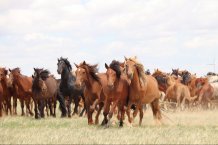Articles

Horses running in the steppes of Inner Mongolia, China, July 2019. Credit Ludovic Orlando
The mystery of horse domestication decoded at last - success of modern horses due to genetic changes which led to more docile behaviour and an improved back
Modern horses owe most of their success to genetic changes which led to more docile behaviour and an improved back, a new study shows.
Experts working to decode the mystery of horse domestication have found a gene that controls anxiety and aggression and a genomic region associated with chronic back pain in humans were modified around 4,000 years ago.
This had an impact on human and horse interactions and their use for long-distance transportation.
The research, published today in the scientific journal Nature, explains the long-standing archaeological mystery of who first domesticated the modern horse, and when the animal spread to the rest of the world, offering new ways to make war and to travel faster.
An international team led by Professor Ludovic Orlando, director of the Centre for Anthropobiology and Genomics of Toulouse (CNRS/Université Paul Sabatier, France), and including 162 scientists worldwide sequenced the genomes of nearly 300 ancient horses from all across Eurasia.
It had been known the period between 4,000 to 6,000 years ago was critical for horse domestication, but the cause of this change was a mystery.
Horses living in Anatolia, Europe, Central Asia and Siberia used to be genetically distinct. Around 4,000 to 4,200 years ago, the situation changed almost overnight: the genetic profile from horses originally found in the southwestern steppes of Russia, in the Pontic-Caspian region, north of the Caucasian mountains, started to spread outside their homeland. Within a few centuries they had replaced all the wild populations that existed, from the Atlantic shores to the Mongolian steppes. The genetic data examined also point to an explosive demography at the time, with no equivalent in the last 100,000 years.
“This is when we took control over the reproduction of the animal and produced them in astronomic numbers so as to sustain what then became a globalized demand,” says Professor Orlando, a research professor with the French National Centre for Scientific Research (CNRS).
The research team found two striking genetic differences with the other horse types then living in Eurasia - a gene that controls anxiety and aggressivity and a genomic region associated with chronic back pain in humans.
“We knew that the time period between 4,000 to 6,000 years ago was critical but no smoking guns could ever be found” says Professor Orlando.
A research team led by Professor Orlando have previously studied horses discovered at Botai, a 5,500 year-old site from Central Asia, known to have provided the first domestic horses in the archaeological record. Their DNA indicated that the animals then domesticated were not the ancestors of modern domestic horses. The origins of thoroughbreds, shires and all the other domestic breeds that we know today had to be somewhere else.
Professor Alan Outram, from the University of Exeter, a senior archaeological author on the paper, said “It was essential for geneticists and archaeologists to work together to solve this mystery. The archaeological evidence pointed to various key times and locations where the horse/human relationship was intensifying, but without the genetics we could not tell which gave rise to our modern domestic horses.”
“It was hiding in the dark” says Dr Pablo Librado, first author of the study, from the Centre for Anthropobiology and Genomics of Toulouse (CNRS/Université Paul Sabatier, France), “as most candidate regions considered in earlier studies could be rejected”.
For this study, rather than focusing on one particular region, the scientific team sequenced as many ancient horses as possible across the entire Eurasian range. This allowed them to reveal a colorful map of Eurasia before domestication.
The study does not just map out the genetic foundation of horse domestication. It also reveals that the new horse type spread into Asia together with spoke-wheeled chariots and Indo-Iranian languages. This was not the case, however, in Europe. The study shows that the massive migrations from the steppes that deeply transformed the genetic makeup of Europeans during the third millennium BCE and triggered the spread of Indo-European languages did not take place on horseback. Horse-mounted warfare can no longer be seen as key to the success of such migrations from the steppes, which was another long-standing and highly-controversial debate in archaeology.
The study was mainly funded by the European Research Council (PEGASUS) programme and the France Génomique ‘Appel à Grand Projet’ (BUCEPHALE).
Date: 20 October 2021
